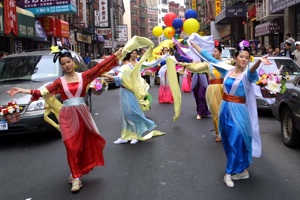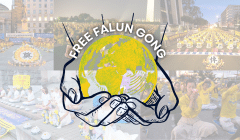A Parade of Culture
Through Falun Gong, people are rediscovering their heritage, and finding joy in sharing it

Dance of the Heavenly beauties. A Falun Gong Parade in Manhattan's China town.
Bright, boisterous floats. The thumping of drums. Colorfully costumed lads, prancing about.
If these are the marks of a parade, then a parade is about the last thing you would associate with a meditation practice. Much less a meditation being ruthlessly suppressed in its homeland of China.
But with growing enthusiasm, followers of Falun Gong are taking to the streets, and not just to protest. There is also something to celebrate. Even something to share. Here, it’s good news all the way.
It’s a tale told, in a sense, by the smile on Tracey Zhu’s face today. She’s performing a Chinese “fan dance” in the annual Chinatown New Year’s parade, seemingly impervious to the nipping winter cold that has others bundled in layers of down and wool.
Zhu’s smile, like the dance, runs deep.
“When I’m performing, I really enjoy sharing with people the beauty of ancient Chinese traditions,” she shares. “From practicing Falun Gong I’ve come to hold them dear to my heart.”
“It’s not just about doing some dance, but an act of sharing. I want to share that dignity, grace, and harmony with the audience.”
For many Falun Gong practitioners like Zhu, cultural performances like this one bespeak of a renewal—of a return.
“Learning Falun Gong, I came to value my own culture more,” says Ying Chen, a systems director from Marlton, New Jersey. “I was born in China right during the Cultural Revolution and never had much of a connection to Chinese culture.”
The Cultural Revolution, which took place from 1966–76, sought to destroy China’s cultural traditions and any who dared continue them. It was an uprooting of China’s very soul, some say.
For Chen and others, Falun Gong has been a new grounding of sorts—a replanting, or nurturing, of cultural roots.
“It was Falun Gong that did it for me,” Chen says. “After practicing it a while I discovered that I was getting more in touch with my roots, and I’ve felt empowered by this connection. It not only allows me to excel here in America, but to do so as a Chinese-American who is grounded in my own culture’s traditional values.”
“It’s the best of both worlds.”
Chen thus took up the flute again recently after years of time off, newly inspired. Others, like Zhu, have similarly found new meaning in arts they had long since dropped, such as dance, calligraphy, music, and even poetry.
But this time around, the performance is different they say. It’s not so much about “self” anymore, but something greater. It has to do with new depths and realms. “It’s about achieving a state of purity and virtue,” Zhu tells—things she relates to doing Falun Gong.
And that, Zhu says, is what makes their arts so different.
“Before when I performed I didn’t really have soul… Now, when there are deeper, traditional values behind it, the performance really has heart.”
“People feel that.”
Bridging hearts, cultures
In New York, Falun Gong has swelled in popularity over the years. That’s how some 400 practitioners came to march in this year’s Chinatown parade.
But things haven’t always been easy.
“We realized a few years back that many people in Chinatown didn’t understand us. They had read and heard too much nonsense from China’s government, which is trying to wipe out Falun Gong,” says Yun Song of Manhattan.
“I think they were confused, and led to think Falun Gong was something weird, or bad. They lost sight of the ancient culture that it comes from.”
In that past culture, however, lay the answer to present tensions.
“So we wanted to show people the beauty and depth of Falun Gong, and that it’s a part of our shared culture. Parades were a nice, friendly setting to do that.”
And so it was that the two parties’ shared heritage proved just the right bridge. Importantly, that heritage is what Falun Gong is all about.
“The practice is deeply rooted in the ancient Chinese world,” offers Erping Zhang, a Mason Fellow at Harvard University’s Kennedy School of Government. “The idea that a person can do ‘self-cultivation’ to physically and mentally remake himself into someone more whole, healthy, or enlightened—that idea is very basic, and key, to Chinese culture.”
Many have made the same connection. Irwin Cotler, Canada’s former Minister of Justice and Attorney General, declared once that, “Falun Gong represents the very best of Chinese culture and values.”
But tragically, before Falun Gong came along, much of that traditional culture was lost, Zhang explains. Beijing’s Communist rulers felt threatened by it.
“They wanted to do away with tradition and Chinese heritage, because to them it undermined or competed with their [European] Marxist ideology, which was not in any way Chinese.”
A lost splendor renewed
The parades began with drum troupes, one interviewee recalled. Waist drums, dating back over a millennia in China, were a natural choice: They resonated with people.
Soon, along came traditional dress and costume, with styles tracing back to China’s legendary Tang Dynasty—a period of tremendous cultural ferment. Their colors and elegant design bespeak of a noble, upright sensibility, participants say.
Dance, often choreographed by the performers and rehearsed for weeks, was a natural extension.
With time many in New York’s Chinatown and beyond have come to see their Falun Gong compatriots anew. Not only fellow Chinese seemed to appreciate the rich cultural performances. So too did Americans.
“This group is bringing the entire parade to a much higher level. They’re bringing the whole thing up,” said one African-American spectator recently.
Another parade-goer mirrored that sentiment. “They’re bringing people together, to be peaceful… the world needs more of this.”
Perhaps the most unlikely affirmation, though, has come in the form of accolades. Close to 30 times now Falun Gong groups have won parade honors. From first prize in San Diego’s St. Patrick’s day parade to “best art design” in Boston and multiple awards in Minnesota, the support has been a welcome surprise.
“What’s really meaningful about it,” says Song, “is that it says we’re part of this [American] culture too, and have something to share with it as Chinese, and as Falun Gong. I think Falun Gong has made us all more giving, and people can sense that energy.”








